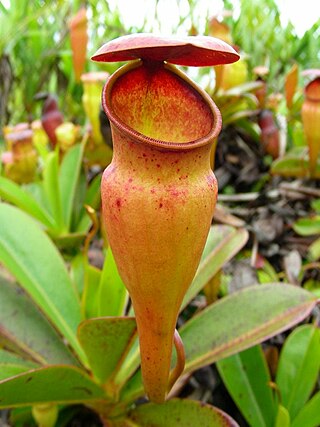
Nepenthes pervillei is the only pitcher plant found in the Seychelles, where it is endemic to the islands of Mahé and Silhouette. It grows in rocky areas near granitic mountain summits, its roots reaching deep into rock fissures. The species has an altitudinal range of 350–750 m above sea level. Like all members of the genus, N. pervillei is dioecious, having separate male and female plants.

The Acaridae are a family of mites in order Sarcoptiformes.
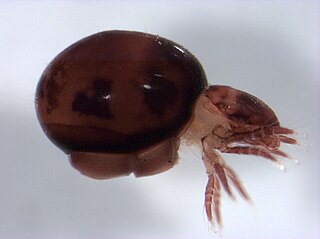
Oribatida, also known as oribatid mites, moss mites or beetle mites, are an order of mites, in the "chewing Acariformes" clade Sarcoptiformes. They range in size from 0.2 to 1.4 millimetres. There are currently 12,000 species that have been identified, but researchers estimate that there may be anywhere from 60,000 to 120,000 total species. Oribatid mites are by far the most prevalent of all arthropods in forest soils, and are essential for breaking down organic detritus and distributing fungi.
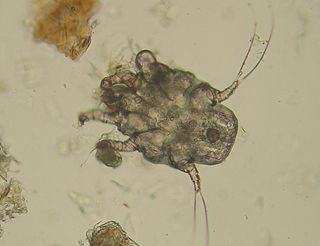
Astigmatina is a clade of mites in the superorder Acariformes. Astigmata has been ranked as an order or suborder in the past, but was lowered to the unranked clade Astigmatina of the clade Desmonomatides in the order Sarcoptiformes. Astigmatina is now made up of the two groups Acaridia and Psoroptidia, which have been suborders of the order Astigmata in the past. Astigmatina contains about 10 superfamilies and 76 families under Acaridia and Psoroptidia.

Poecilochirus is a Holarctic genus of mites in the family Parasitidae. They are relatively large and often found on rotting corpses, where they are transported by beetles. Deuteronymphs are characterized by two orange dorsal shields and in many species a transverse band on the sternal shield. The juvenile development consists of a larval stage, protonymph, and deuteronymph, but no tritonymph. Females are smaller than males. Males guard female deuteronymphs shortly before these mate, and pairs mate venter-to-venter.

Histiostoma is a genus of mites in the family Histiostomatidae.
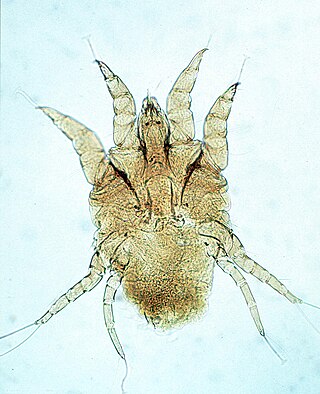
Sarcoptoidea is a superfamily of mites, including many associated with mammals.
The Macronyssidae are a family of parasitic mites in the order Mesostigmata.

The Laelapidae are a family of mites in the order Mesostigmata. The family is also referred to in the literature as Laelaptidae, which may be the correct spelling.
Prolistrophorus bakeri is a parasitic mite in the genus Prolistrophorus. Together with the Argentine P. hirstianus, it forms the subgenus Beprolistrophorus. P. bakeri has been found on the hispid cotton rat, marsh rice rat, and cotton mouse in Georgia, South Carolina, Texas, and Florida and on Oryzomys couesi in Colima. It was formerly placed in the genus Listrophorus.
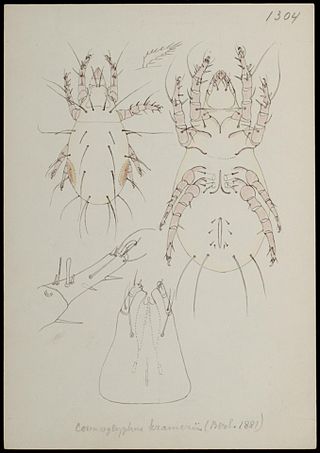
Cosmoglyphus is a genus of mites in the family Acaridae.
Schwiebea is a genus of mites in the family Acaridae. It is among the largest in the family with over 60 species.
Ascidae is a family of mites in the order Mesostigmata.

Phoresis or phoresy is a temporary commensalistic relationship when an organism attaches itself to a host organism solely for travel. It has been seen in ticks and mites since the 18th century, and in fossils 320 million years old. It is not restricted to arthropods or animals; plants with seeds that disperse by attaching themselves to animals are also considered to be phoretic.
Hans-Jürgen Stammer was a German zoologist, ecologist and director of the Zoological Institute of the University Erlangen.
Chaetodactylus is a genus of parasitic mite primarily associated with solitary bees with over 20 species.

Winterschmidtiidae is a family of mites in the order Astigmata.
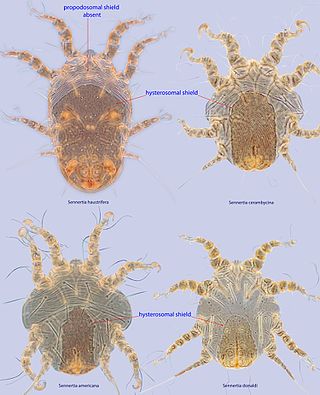
Sennertia is a genus of mites in the Chaetodactylidae family. There are more than 70 species. Some of these mites are parasites or commensals of bees, but the presence in some bees of specialized structures for carrying mites (acarinarium) indicates the mutualistic nature of the relationship of some species. Most species of the genus Sennertia settle on adult bees as heteromorphic deutonymphs, but the species Sennertia vaga has no deutonymph and settle on adult bees in the eating adult stages. Reproduction and feeding occurs during resettlement. Most species occur on small carpenter bees (Ceratina) and large carpenter bees (Xylocopa) of the family Apidae. A few species are associated with Centris (Paracentris) in the Neotropics.

Galumna is a genus of mites in the family Galumnidae.
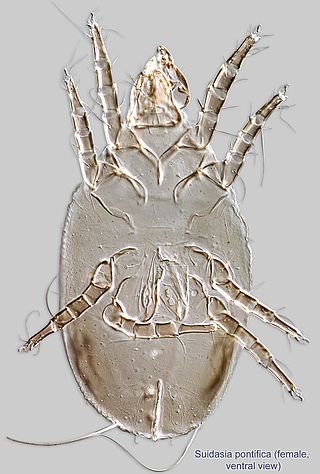
Suidasia is a genus of mites in the family Suidasiidae and clade Astigmatina.















